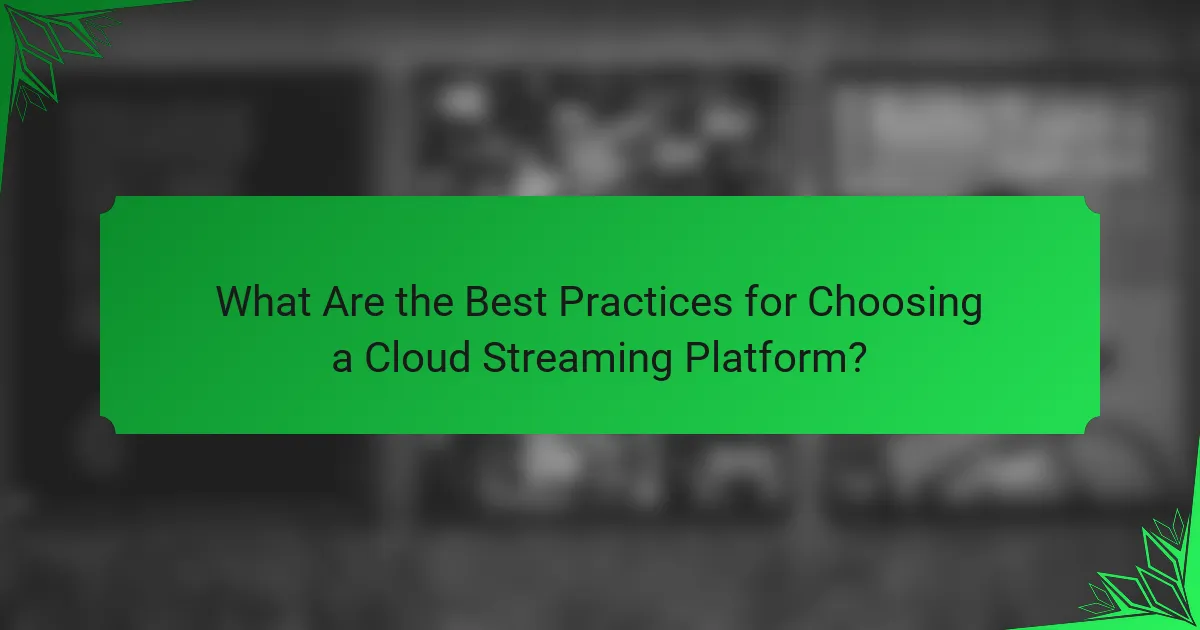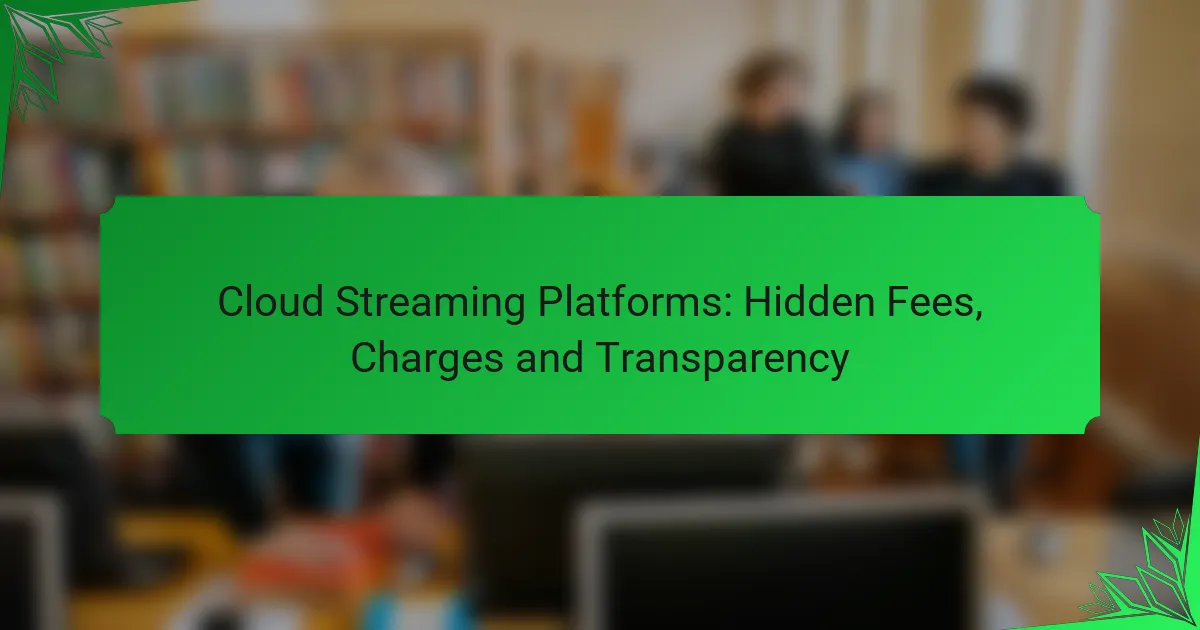As cloud streaming platforms gain popularity, consumers must be aware of the hidden fees that can inflate their overall costs. These charges, which may include subscription fees and data overage costs, are often not clearly disclosed at the time of sign-up. Understanding the varying pricing structures and levels of transparency across different services is crucial for making informed decisions that align with both budget and viewing preferences.

What Are the Hidden Fees in Cloud Streaming Platforms?
Hidden fees in cloud streaming platforms can significantly increase your overall costs. These charges often include subscription fees, data overage charges, and other unexpected costs that may not be immediately apparent when signing up.
Subscription fees
Subscription fees are the most common hidden costs associated with cloud streaming platforms. While many services advertise low monthly rates, they may not include taxes or additional charges, which can raise the total cost. Always check the fine print for any extra fees that may apply.
Some platforms offer tiered subscription models, where higher tiers provide additional features or content access. Consider whether the benefits of a premium tier justify the increased cost.
Data overage charges
Data overage charges occur when you exceed your allotted data usage, which can happen with streaming services that have data caps. These fees can add up quickly, especially if you frequently stream high-definition content. It’s crucial to monitor your data usage to avoid unexpected charges.
Many providers offer unlimited data plans, but they may come with higher monthly fees. Evaluate your streaming habits to determine if an unlimited plan is worth the investment.
Device compatibility fees
Device compatibility fees may apply if you want to use a cloud streaming service on multiple devices. Some platforms charge extra for access on specific devices or require additional subscriptions for smart TVs or gaming consoles. Always verify which devices are included in your subscription.
Check if the service offers a family plan or multi-device access at a discounted rate, which can save you money if multiple users in your household want to stream simultaneously.
Content rental costs
Content rental costs can be a significant hidden fee in cloud streaming platforms, particularly for newer releases or premium content. While a subscription may grant access to a library of films and shows, many platforms charge separately for renting or purchasing specific titles.
Be aware of these additional costs when planning your viewing, as they can quickly add up if you frequently rent movies or shows that are not included in your subscription.
Premium access fees
Premium access fees are charges for exclusive content, early releases, or ad-free viewing experiences. While these features can enhance your streaming experience, they often come with an additional monthly fee on top of your standard subscription.
Evaluate whether the premium features align with your viewing preferences. If you rarely use the exclusive content, it may be more economical to stick with the basic plan.

How Do Charges Vary by Platform?
Charges for cloud streaming platforms can differ significantly based on their pricing structures, subscription tiers, and additional fees. Understanding these variations helps consumers make informed choices about which service best fits their budget and viewing preferences.
Netflix pricing structure
Netflix offers a tiered pricing structure with multiple subscription plans. As of late 2023, users can choose from basic, standard, and premium options, typically ranging from around $10 to $20 per month. Each plan varies in terms of video quality and the number of simultaneous streams allowed.
It’s important to note that Netflix does not charge additional fees for content, but users should be aware of potential price increases that may occur annually. Always check for promotional offers that might provide temporary discounts.
Amazon Prime Video fees
Amazon Prime Video is included with an Amazon Prime membership, which costs approximately $14 per month or $139 annually. However, some titles may require additional rental or purchase fees, which can range from a few dollars to around $20 for new releases.
Users should consider whether they will frequently rent or buy content, as these extra charges can add up. Additionally, Prime members can access exclusive deals and discounts on other Amazon services, enhancing overall value.
Hulu subscription tiers
Hulu offers several subscription tiers, including a basic plan with ads and an ad-free option, typically priced between $8 and $15 per month. There are also bundle options available that include Disney+ and ESPN+, providing more content for a slightly higher fee.
Hulu’s pricing can be affected by promotional offers, so it’s wise to keep an eye out for special deals. Users should also be aware of potential add-ons, such as premium channels, which can increase monthly costs.
Disney+ additional costs
Disney+ operates on a straightforward subscription model, generally costing around $10 per month. Unlike some platforms, Disney+ does not charge for additional content, but users should be mindful of any bundle deals that may include Hulu or ESPN+ for a combined fee.
Occasionally, Disney+ may offer limited-time promotions or discounts for new subscribers. Always review the terms of these offers to ensure you understand any potential changes in pricing after the promotional period ends.

What Are the Transparency Levels of Major Platforms?
The transparency levels of major cloud streaming platforms vary significantly, impacting how users understand fees and charges. While some platforms offer detailed reports and clear user agreements, others may obscure additional costs, making it essential for consumers to read the fine print.
Netflix transparency report
Netflix provides a transparency report that outlines its content acquisition and licensing costs, helping users understand where their subscription fees go. However, the report does not detail additional charges, such as taxes or potential fees for premium content, which can lead to unexpected costs.
Users should regularly check the Netflix help center for updates on pricing changes and service terms to stay informed about any modifications that may affect their subscriptions.
Amazon Prime Video user agreements
Amazon Prime Video’s user agreements are comprehensive, detailing subscription costs and any additional charges for rentals or purchases. While the platform is generally transparent about its fees, users should be aware of potential hidden costs associated with add-on channels or premium content.
It’s advisable to review the terms of service before subscribing, as this can prevent surprises related to billing and ensure users are aware of all potential charges.
Hulu fee disclosures
Hulu offers clear fee disclosures, outlining subscription tiers and any associated costs for add-ons like live TV or premium channels. However, users should pay attention to promotional pricing, as these offers often revert to higher rates after a set period.
To avoid unexpected charges, users should keep track of when promotional periods end and what the new subscription rates will be.
Disney+ pricing clarity
Disney+ maintains a straightforward pricing structure, with clear information on subscription options and any additional fees for bundled services. The platform is transparent about its pricing, but users should be cautious of potential regional variations in pricing and content availability.
Checking the Disney+ website for the latest pricing information and any special offers can help users make informed decisions about their subscriptions.

How to Identify and Avoid Hidden Charges?
To identify and avoid hidden charges on cloud streaming platforms, carefully review all terms and conditions, and stay vigilant about your billing. Understanding the fees associated with your subscription can save you from unexpected costs.
Read user agreements
User agreements often contain crucial information about potential hidden fees. Take the time to read these documents thoroughly, focusing on sections related to billing, cancellation policies, and any additional charges that may apply.
Look for terms like “administrative fees,” “overage charges,” or “service fees.” These can significantly impact your overall costs, so understanding them upfront is essential.
Monitor billing statements
Regularly checking your billing statements can help you spot any discrepancies or unexpected charges. Set a reminder to review your statements monthly, ensuring that all charges align with your subscription plan.
If you notice unfamiliar charges, contact customer support immediately to clarify their origin. Keeping a record of your subscriptions and their costs can also help in tracking any changes over time.
Use comparison tools
Comparison tools can be invaluable in identifying which cloud streaming platforms offer the best value without hidden fees. Websites that aggregate user reviews and pricing can provide insights into the true costs associated with different services.
When using these tools, focus on platforms that clearly disclose their pricing structures. This transparency can help you make informed decisions and avoid platforms known for hidden charges.

What Are the Best Practices for Choosing a Cloud Streaming Platform?
Choosing a cloud streaming platform requires careful consideration of various factors, including cost, user experience, and reliability. Prioritizing transparency and understanding potential hidden fees can significantly impact your overall satisfaction and budget.
Evaluate total cost of ownership
When assessing the total cost of ownership for a cloud streaming platform, consider not only the subscription fees but also any additional charges that may arise. These can include bandwidth costs, storage fees, and charges for premium features or support services.
To get a clearer picture, create a detailed budget that includes all potential expenses. For instance, if a platform offers a low monthly fee but high data transfer costs, it may end up being more expensive than a competitor with a higher base rate but no extra charges.
Consider user reviews
User reviews provide valuable insights into the real-world performance and reliability of cloud streaming platforms. Look for feedback on aspects such as ease of use, customer support responsiveness, and any hidden fees that users have encountered.
To make an informed decision, check multiple review sources and focus on recent comments. Pay attention to patterns in the feedback; if many users report issues with billing transparency or service reliability, it may be a red flag. Aim for platforms with a strong reputation for customer satisfaction and clear pricing structures.
